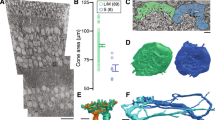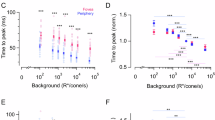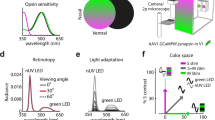Abstract
We developed a physiologically plausible model of the first steps of spatial visual information processing in the fovea of the human retina. With the predictions of this model we could support the hypothesis that, for moderate contrasts (≤ 40%), hyperacuity is mediated by the magnocellular (MC-) pathway. Despite the lower sampling density in the MC pathway, as compared to the parvocellular (PC-) pathway, the information that is transferred by the MC ganglion cells is sufficient to achieve thresholds comparable to those of human subjects in psychophysical tasks. This is a result of the much higher signal-to-noise ratio of the MC pathway cell signals. The PC pathway cells do not transfer enough information for hyperacuity thresholds.
Similar content being viewed by others
References
Ahnelt PK, Kolb H, and Pflug R (1987) Identification of a subtype of cone photoreceptor, likely to be blue sensitive, in the human retina. J. Comp. Neurol. 255:18–34.
Croner LJ and Kaplan E (1995) Receptive fields of P and M ganglion cells across the primate retina. Vision Res. 35:7–24.
Croner LJ, Purpura K, and Kaplan E (1993) Response variability in retinal ganglion cells of primates Proc. Natl. Acad. Sci. USA 90:8128–8130.
Geisler WS and Davila KD (1985) Ideal discriminators in spatial vision: Two-point stimuli. J. Opt. Soc. Am. A 2:1483–1497.
Green DM and Swets JA (1974) Signal detection theory and psychophysics. Krieger Publishing, New York.
Grünert U, Greferath U, Boycott BB, and Wässle H (1993) Parasol (Pα) ganglion-cells of the primate fovea: Immunocytochemical staining with antibodies against GABAA-receptors. Vision Res. 33:1–14.
Hirsch J (1984) Quality of the primate photoreceptor lattice and limits of spatial vision. Vision Res. 24:347–355.
Kaplan E and Shapley RM (1986) The primate retina contains two types of ganglion cells, with high and low contrast sensitvity. Proc. Natl. Acad. Sci. USA 83:2755–2757.
Lee BB, Martin PR, and Valberg, A (1989) Sensitivity of macaque retinal ganglion cells to chromatic and luminance flicker. J. Physiology 414:223–243.
Lee BB, Wehrhahn C, Westheimer G, and Kremers J (1993) Macaque ganglion cell responses to stimuli that elicit hyperacuity in man: detection of small displacements. J. Neuroscience 13, 1001–1009.
Lee BB, Wehrhahn C, Westheimer G, and Kremers J (1995) The spatial precision of macaque ganglion-cell responses in relation to vernier acuity of human observers. Vision Res. 35, 2743–2758.
Lindblom B and Westheimer G (1989) Binocular summation of hyperacuity tasks. J. Opt. Soc. Am. A 4:585–589.
Miller WH and Bernard GD (1983) Averaging over the foveal receptor aperture curtails aliasing. Vision Res. 23:1365–1369.
Naka KI and Rushton WAH (1966) S-potentials from color units in the retina of fish (Cyprinidae) J. Physiology 185:536–555.
Navarro R, Artal P, and Williams DR (1993) Modulation transfer of the human eye as a function of retinal eccentricity. J. Opt. Soc. Am. A 10:201–213.
Perry VH, Oehler R, and Cowey A (1984) Retinal ganglion cells that project ot the dorsal lateral geniculate nucleus in the macaque monkey. Neuroscience 12:1101–1123.
Shapley R and Victor J (1986) Hyperacuity in cat retinal ganglion cells. Science 231: 999–231.
Silveira LCL and Perry VH (1991) The topography of magnocellular projecting ganglion cells (m-ganglion cells) in the primate retina. Neuroscience 40:217–237.
Snippe HP and Koenderink JJ (1992) Discrimination thresholds for channel-coded systems. Biological Cybernetics 66, 543–551.
Wässle H and Boycott BB (1991) Functional architecture of the mammalian retina. Physiological Reviews 71:447–480.
Wässle H, Grünert U, Röhrenbeck J, and Boycott BB (1990) Retinal ganglion cell density and cortical magnification factor in the primate. Vision Res. 30:1897–1911.
Wässle H and Riemann HJ (1978) The mosaic of nerve cells in the mammalian retina. Proc. R. Soc. London B 200:441–461.
Watanabe M and Rodieck RW (1989) Parasol and midget ganglion cells of the primate retina. J. Comp. Neurology 289:434–454.
Watt RJ and Campbell FW (1985) Vernier acuity: Interactions between length effects and gaps when orientation cues are eliminated. Spatial Vision 1:31–38.
Wehrhahn C and Westheimer G (1990) How vernier acuity depends on contrast. Exp. Brain Res. 80:618–620.
Westheimer G (1986) The eye as an optical instrument. Handbook of Perception and Human Performance (Vol. 1). John Wiley & Sons, New York.
Westheimer G (1987) Visual acuity and hyperacuity: Resolution, localization, form. Am. J. of Optometry & Physiological Optics 64:567–574.
Westheimer G and Hauske G (1975) Temporal and spatial interference with vernier acuity. Vision Res. 15:1137–1141.
Westheimer G and McKee SP (1977) Spatial configurations for visual hyperacuity. Vision Res. 17:941–947.
Westheimer G and Pettet MW (1990) Contrast and duration of exposure differentially affect vernier and stereoscopic acuity. Proc. R. Soc. Lond. B 241:42–46.
Author information
Authors and Affiliations
Rights and permissions
About this article
Cite this article
Wachtler, T., Wehrhahn, C. & Lee, B.B. A simple model of human foveal ganglion cell responses to hyperacuity stimuli. J Comput Neurosci 3, 73–82 (1996). https://doi.org/10.1007/BF00158338
Received:
Revised:
Issue Date:
DOI: https://doi.org/10.1007/BF00158338




